How to Make Sopes
If you’ve yet to try the little rounds of joy known as Mexican Sopes, you’re in for a treat. These thick masa cakes have a slightly crisp exterior, a warm and tender interior, and are perfect for loading up with all your favorite toppings. Simply made with just 3 ingredients, these yummy little sopitos are the versatile, budget-friendly meal template you need to try.
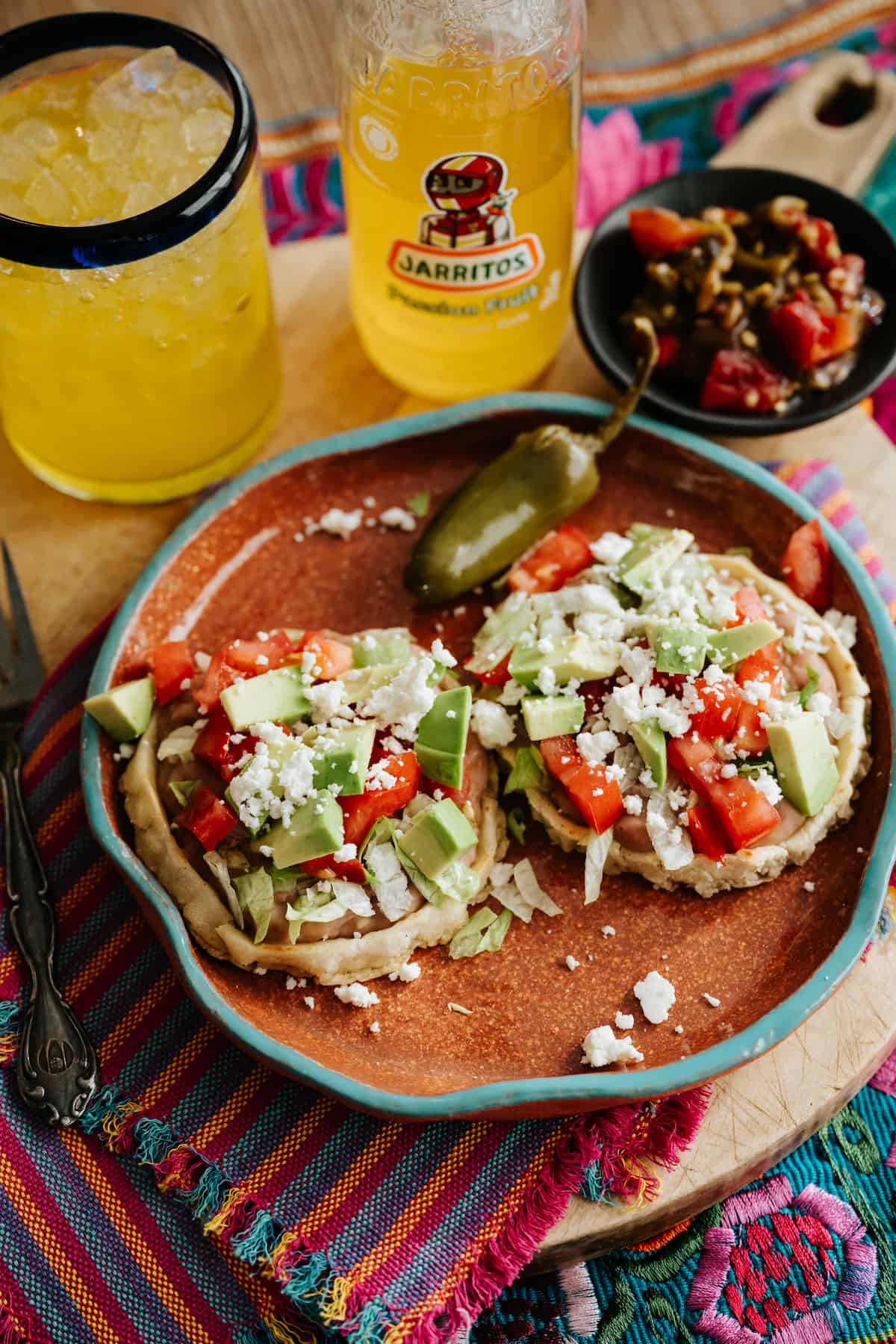
What are Sopes?
Originally from the central and southern parts of Mexico, a sope is a masa cake that’s reminiscent of a thick corn tortilla, but with the edges pinched up to create a well in the center to hold your favorite toppings.
To be honest, sopes are much easier to make than corn tortillas because they don’t have to be as thin or as perfect. And, since they’re made with just a few pantry staples and can be filled with just about ANYTHING, they’re the ideal meal to make when you’re low on groceries.
These tasty treats are a popular street food across Mexico and are called by several additional names. Some folks refer to them as pellizcadas, picaditas, or picados which are all ways of saying “pinched” — an apt name since you pinch the borders. They are also sometimes called corrales because they look like mini corrals.
Mexican sopes are part of a category of dishes called antojos, or antojitos, which translates to “little cravings.” My daughter can attest to the fact that this is an excellent description of sopes — they’ve been her favorite snack since she had to stand on her tippy-toes to reach the counter. Nowadays, she’s the girl reaching to get me something out of a tall cabinet when I can’t reach it.
Ingredients & Substitutions
As promised, you only need a small handful of ingredients to make this sopes Mexicanos recipe. See recipe card below for the full recipe.
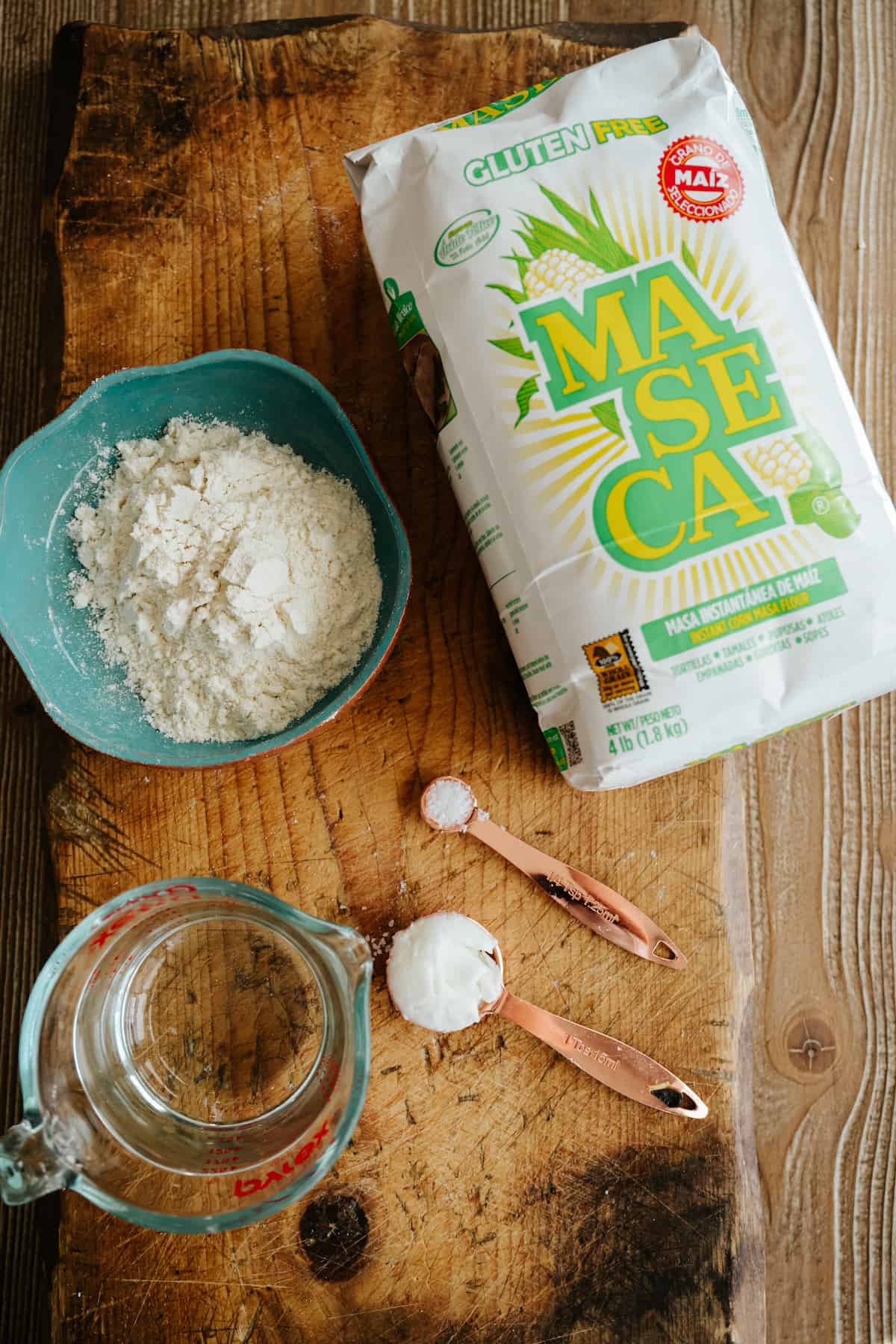
- Masa Harina: This nixtamalized corn flour is a key ingredient in everything from tortillas and tamales to atole and champurrado. Nowadays, you should be able to find it in the Latin American aisle or flour aisle of any major grocery store. Otherwise, look online or at any Mexican grocer.
- Salt: A bit of seasoning helps bring out the sweet corn flavor of masa harina.
- Shortening: Don’t be shy with the fat here; it’s what makes these sopes so tender and delicious!
- Warm Water: Okay, sticklers. You got me. This is the 4th ingredient, but it’s water. I highly recommend very warm water.
How to Make Sopes Mexicanos
Many traditional recipes call for deep-frying sopes, but I prefer simply pan-frying them with just a touch of oil. Not only are they lighter this way, but you also don’t have to deal with the hassle of filtering or disposing of the frying oil. Here’s how to cook sopes the Muy Bueno way.
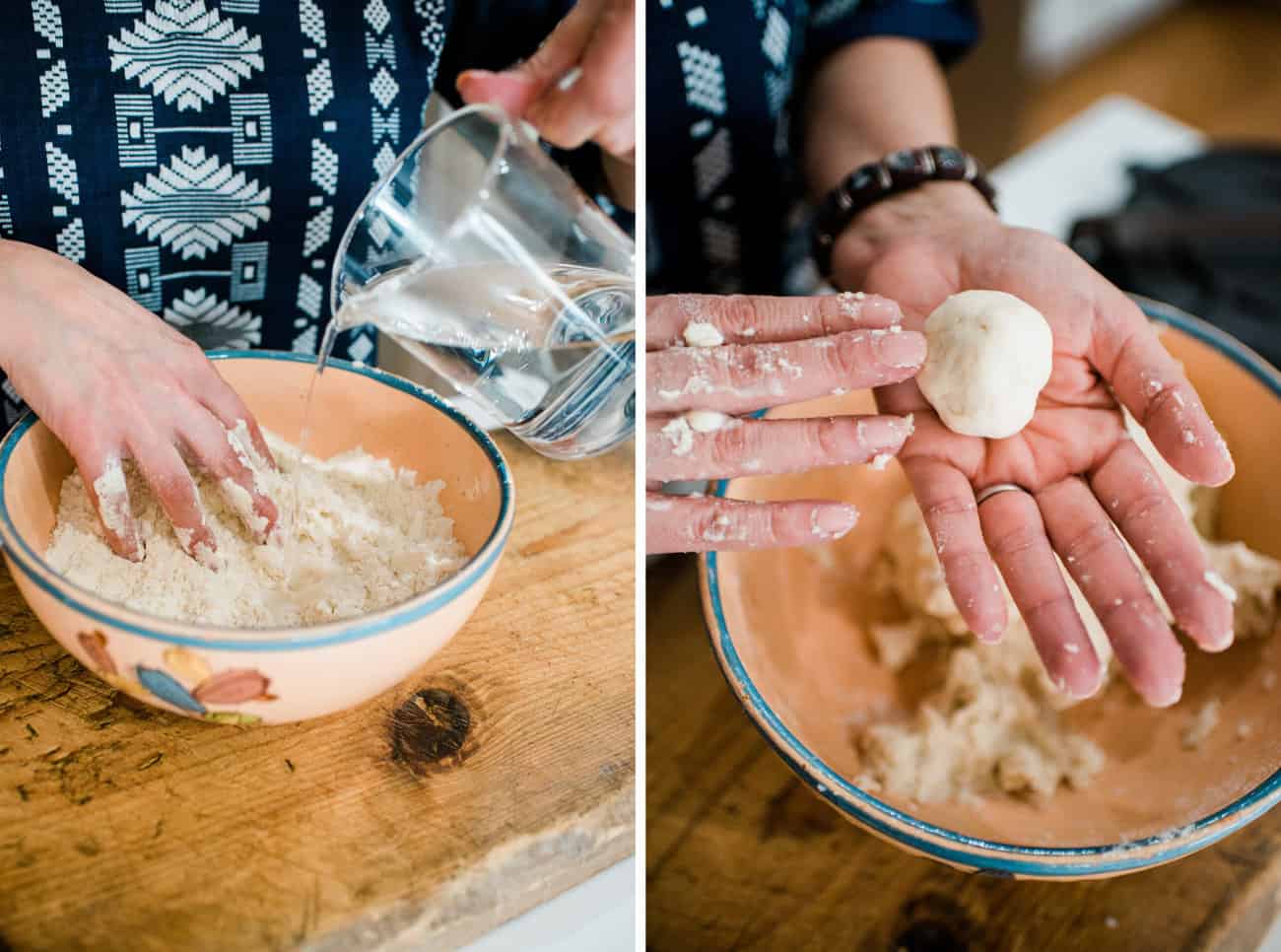
Combine: Simply combine the masa harina and salt. Cut in the shortening with the dry ingredients and slowly add in the water until dough forms.
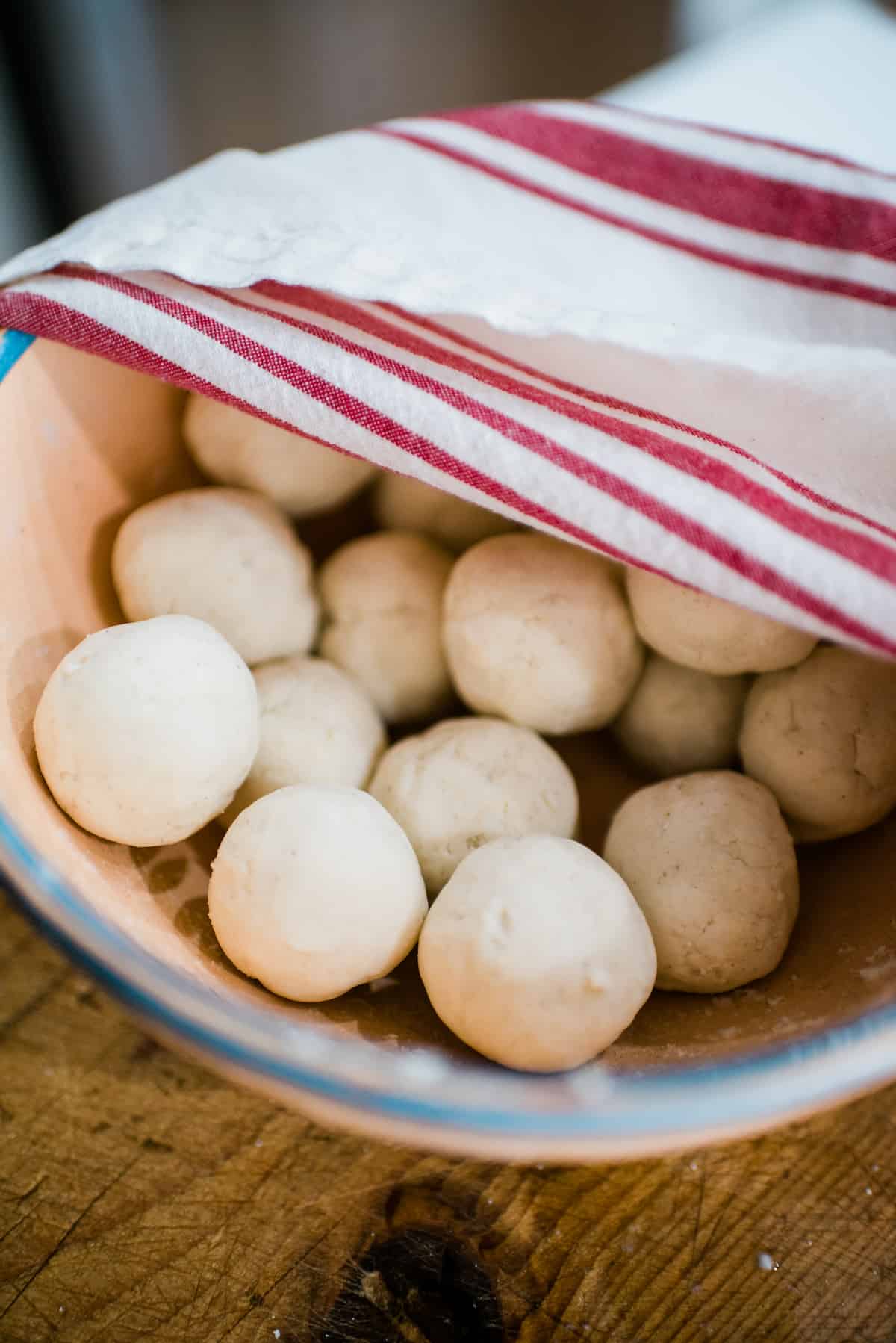
Divide dough into balls: Cover with a damp cloth to keep the dough soft and moist.
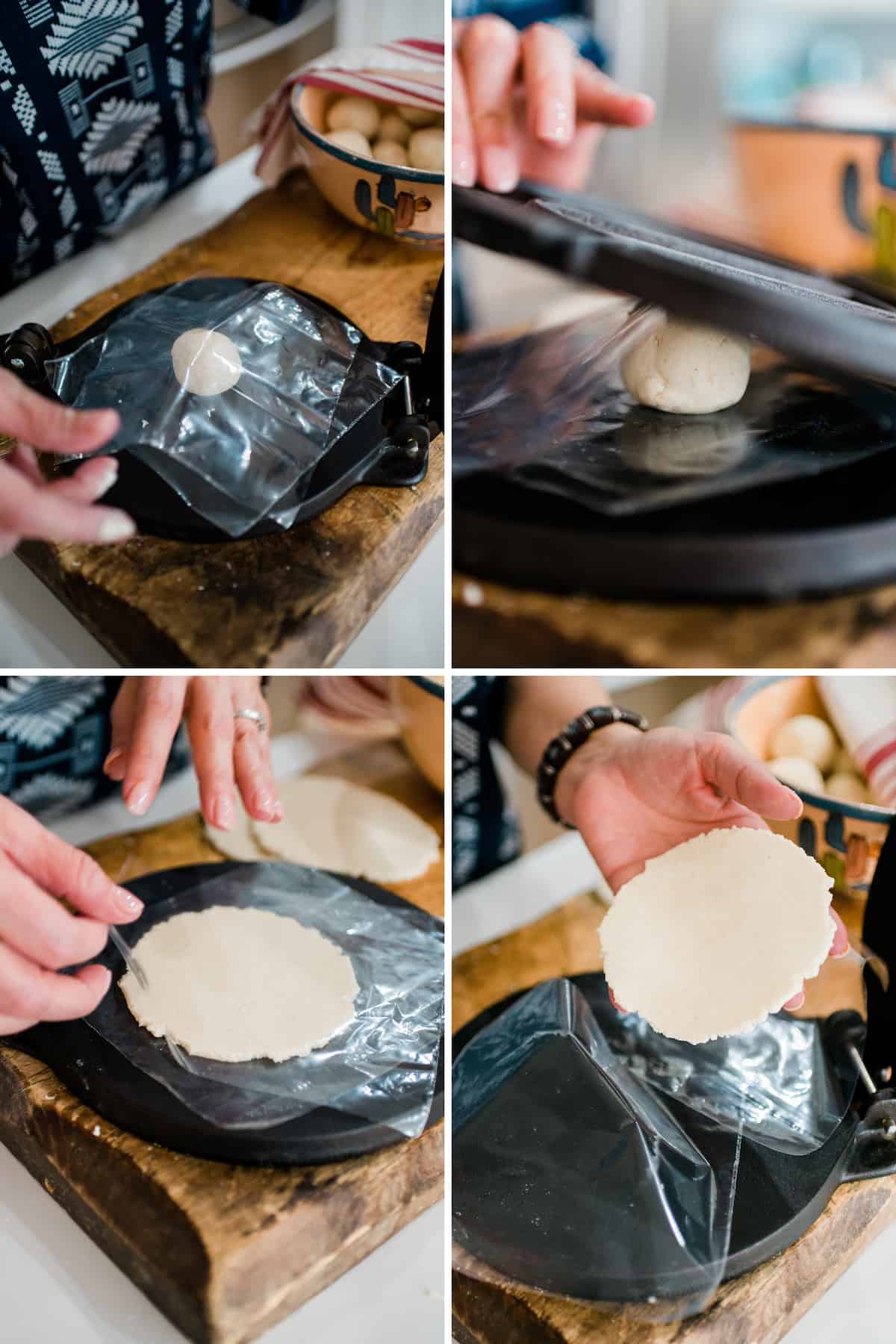
Press: You can use a tortilla press to press the dough balls into little circles. If you don’t have a tortilla press you can use a heavy skillet or heavy dish to make the dough patties or use your hands to form a patty.
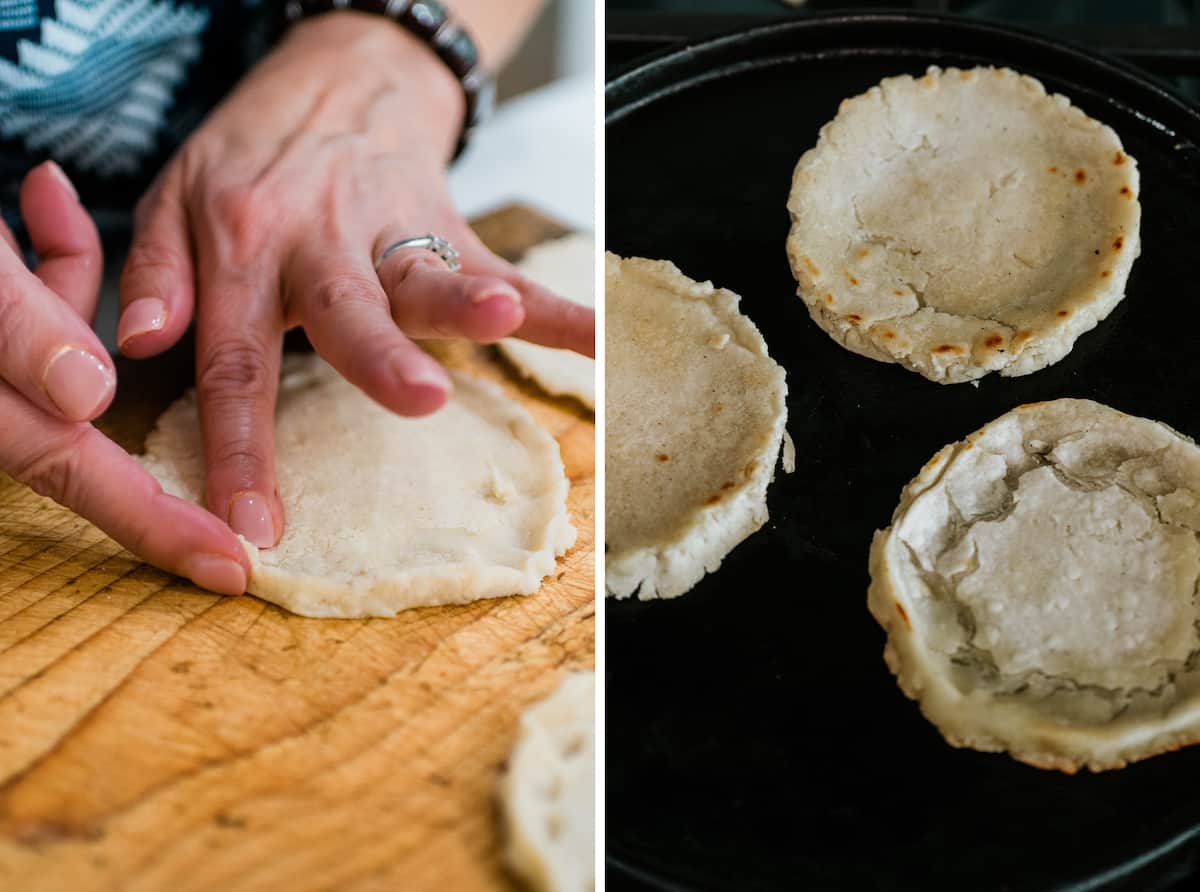
Cook: Heat a griddle or a comal over medium-high heat. Place sopes on the hot griddle and cook for 2-3 minutes per side until dry.
Form: While the partially cooked patty is still warm and as soon as you are able to handle it, pull the dough of the patty up and outward towards the edge, creating a little ridge of dough all the way around the circle to create a little “boat” or sope.
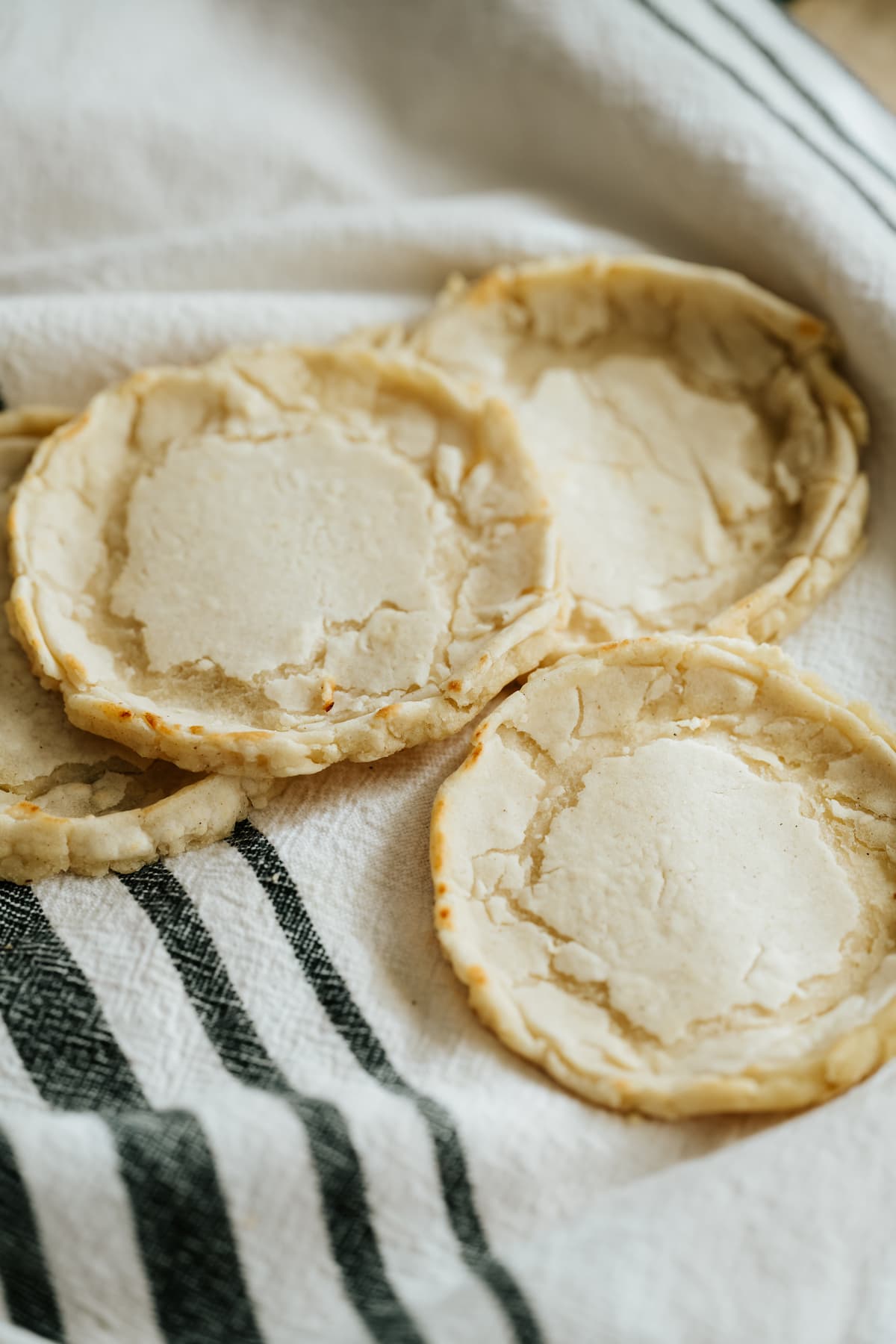
Brown: Add a drizzle of oil to the pan and cook sopes until lightly browned and slightly crispy on each side.
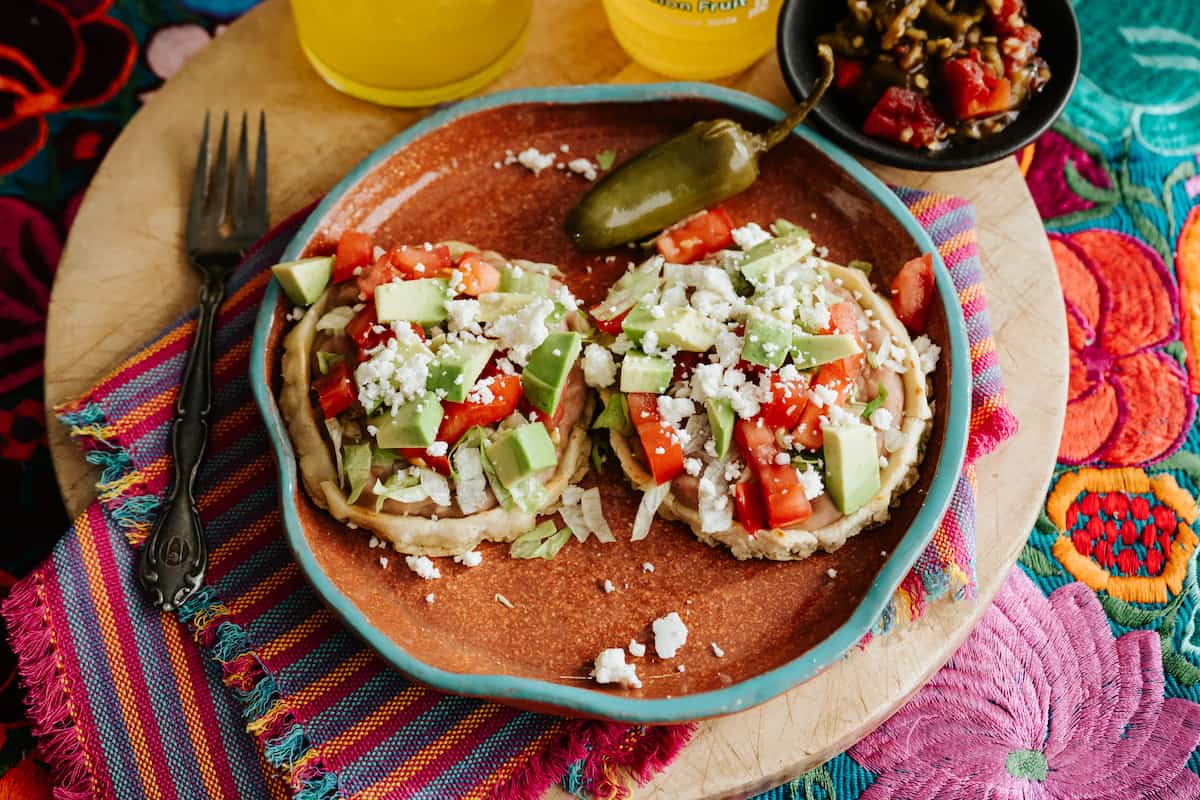
Fill: Fill each sope shell with the filling of your choice and garnish with your favorite toppings. Enjoy!
Optional Variations
- Sopecitos: Have an event coming up? Make mini sopes (a.k.a. sopecitos). Top with a variety of salsas and a sprinkle of queso fresco for a special antojito.
- Huaraches: These unique, larger, oval-shaped variations on sopes are excellent if you and your crowd are extra hungry.
- Blue Sopes: Want a real stunner on the plate? Make bright purpley-blue sopes using masa azul (blue corn masa harina).
- Fried Sopes: While I prefer to shallow pan-fry my sopes until browned, you’re welcome to deep fry them instead. Heat a minimum of 2 inches of neutral oil (e.g. canola or peanut) until 350-375F. Gently slide a few sopes into the oil — it should bubble furiously. Allow to cook for a few minutes until golden brown, gently flipping them to ensure both sides cook evenly. Carefully remove the fried picados from the oil, placing them well-side down on a paper towel-lined plate to drain.
Toppings for Sopes
My daughter loves sopes filled with shredded brisket, chicken mole, chicken tinga, al pastor, or carne asada. Other favorites are simple fillings like refried beans or salsa and a sprinkling of queso fresco. The great thing about these masa sopes is you can fill them with leftovers to create a brand new meal or fill them with whatever your heart desires!
- Sopes de Asada: Dice carne asada and use your favorite taco or nacho toppings to dress up your sopes de carne asada.
- Sopes de Pollo: Chicken mole sopes are some of my favorites, but you can also use chicken tinga or ensalada de pollo instead.
- Sopes de Carne Molida: Ground meat is a perfect inexpensive filling option. I love sopes de picadillo, but feel free to swap in the ground meat mixture of your choice.
- Sopes de Frijoles: If you’re looking for vegetarian sopes ideas, you can’t go wrong with refried beans.
- Sopes de Nopales: This ensalada de nopales makes for another delightful vegetarian sope filling.
- Sopes de Tinga: Pork tinga sopes are always a hit. Feel free to use chicken tinga instead!
- Sopes de Chicharron: If you love bacon, you’ll love the pork belly dish known as chicharrones.
- Sopes de Chorizo: This potato chorizo mixture is delightful, or you can use my huevos con chorizo as another filling for breakfast sopes.
- Brisket Sopes (Sopes con Carne Deshebrada): This simple slow cooker brisket recipe makes plenty of leftovers. Give them a delicious glow-up by serving in these tender pellizcadas.
Expert Tips & Tricks
- Consistency is Key: We’re going for a Play-Do-like consistency for this sopes recipe. It should be soft and pliable without being sticky.
- Shape: After rolling the masa into balls, gently press them to form thick, small circles. The edges should be pinched to create a small rim, which acts as a barrier to hold the toppings. Practice makes perfect, so don’t worry if your first few sopes aren’t perfectly shaped. They’ll still be delicious!
- Thick is Best: The thickness of the sope is crucial. It should be thick enough to hold a generous amount of toppings without breaking, but not so thick that it becomes doughy or undercooked. Aim for about ½-inch thickness
- Garnishes: Finish your sopes with fresh garnishes like chopped cilantro, diced onion, sliced radishes, or a squeeze of lime to add some bright contrast to any rich toppings.
Frequently Asked Questions
While both huaraches and sopes are made from masa and can be topped with dozens of delicious things, it’s their shape and size that set them apart. Huaraches are stretched into an oblong shape like the sole of a sandal (that’s actually why they’re called “huaraches,” which means sandals in Spanish). Sopes, on the other hand, are smaller, round, and a bit thicker. After rolling the masa dough into a ball, it’s pressed into a thick, round shape with a little rim around the edge to hold all the toppings. This rim is a key feature of sopes and helps keep everything from spilling out.
The key difference? Shape and how they’re filled. Sopes are open on the top like little plates, while gorditas are stuffed, making them more like a pita pocket.
Tacos are all about what’s inside the thin corn or flour tortilla, which you fold and eat with your hands. Sopes, on the other hand, have a thick, sturdy masa base, often requiring utensils to tackle.
Imagine a corn tortilla, but it’s been fried or baked until it’s super crispy, almost like a big tortilla chip. That’s your tostada base. Then, you pile on toppings — similar to what you’d put on a sope, but the key difference here is the base is flat and really crunchy. Tostadas are usually larger than sopes and eaten with your hands, often a bit messily (but that’s part of the fun!).
It depends on the size and how loaded your sope is. If it’s piled high with toppings, it’s usually easier to start with a fork and knife. But if it’s less loaded or you’re feeling adventurous, go ahead and use your hands! Just be prepared for a bit of delicious messiness.
Absolutely! My Mexican sope recipe yields sope shells that are naturally vegan. Just make sure you choose vegan toppings and you’re good to go!
Yep! This sopes Mexicanos recipe calls for masa harina, which is what Maseca is. (Maseca is just the brand name.) Feel free to use any brand of masa harina you have!
Storage & Heating Instructions
- Sopes are best enjoyed freshly made. Serve them warm, as soon as they’re topped, to enjoy the contrast of the crispy base with the fresh, flavorful toppings.
- Fridge: You can also prepare the masa cakes in advance and refrigerate them for up to 4 days.
- Freeze: Individually wrap each sope or bundle 3-4 pieces with plastic wrap. Place them in a bag and store in the freezer for up to 3 months.
- Re-Heat: When you’re ready to serve the premade sopes, simply reheat them on the comal, add toppings, and enjoy.
More Mexican Recipes
If you made this sopes recipe, please let me know how it turned out! I love hearing from you in the comments and reviews.
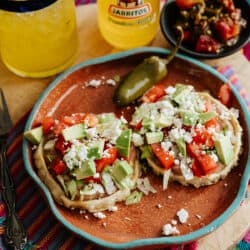
Mexican Sopes Recipe
Ingredients
- 2 cups masa harina, corn flour
- ¼ teaspoon salt
- 1 tablespoon shortening
- 1¼ cups warm water
Instructions
- In a mixing bowl combine the masa harina and salt. Add the shortening and rub in with your fingers so that it is evenly distributed. Add warm water and knead until mixture is smooth and slightly sticky. If the dough is dry add more water, 1 tablespoon at a time. Dough should be soft and moist like play-doh and not dry. Divide dough into 8 portions. Cover with a damp cloth to keep the dough soft and moist.
- Line a tortilla press with plastic wrap. Place a ball of dough on the press and cover with another piece of plastic wrap and press down to form a little 1/4-inch-thick patty. Peel off the plastic wrap. (If you don’t have a tortilla press you can use a heavy skillet or pot to make the dough patties or use your hands to form a patty.) Repeat with remaining balls of dough.
- Preheat a lightly greased comal (griddle) with olive oil on medium-high heat. Cook a patty on the comal for about 2 to 3 minutes on each side until dry.
- While the partially cooked patty is still warm and as soon as you are able to handle it, pull the dough of the patty up and outward towards the edge, creating a little ridge of dough all the way around the circle to create a little “boat” or sope. Repeat with the remaining patties.
- Add a drizzle of oil to the pan and cook sopes until lightly browned and slightly crispy on each side.
- Fill each sope with the filling of your choice and garnish with your favorite toppings.
Video
Notes
-
- Sopes are best enjoyed freshly made. Serve them warm, as soon as they’re topped, to enjoy the contrast of the crispy base with the fresh, flavorful toppings.
- Fridge: You can also prepare the masa cakes in advance and refrigerate them for up to 4 days.
- Freeze: Individually wrap each sope or bundle 3-4 pieces with plastic wrap. Place them in a bag and store in the freezer for up to 3 months.
- Re-Heat: When you’re ready to serve the premade sopes, simply reheat them on the comal, add toppings, and enjoy.
- Sopes de Asada: Small dice your carne asada, then use your favorite taco or nacho toppings to dress up your sopes de carne asada.
- Sopes de Pollo: Chicken mole sopes are some of my favorites, but you can also use chicken tinga or ensalada de pollo instead.
- Sopes de Carne Molida: Ground meat is a perfect inexpensive filling option. I love sopes de picadillo, but feel free to swap in the ground meat mixture of your choice.
- Sopes de Frijoles: If you’re looking for vegetarian sopes ideas, you can’t go wrong with refried beans.
- Sopes de Nopales: This ensalada de nopales makes for another delightful vegetarian sope filling.
- Sopes de Tinga: Pork tinga sopes are always a hit. Feel free to use chicken tinga instead!
- Sopes de Chicharron: If you love bacon, you’ll love the pork belly dish known as chicharrones.
- Sopes de Chorizo: This potato chorizo mixture is delightful, or you can use my huevos con chorizo as another filling for breakfast sopes.
- Brisket Sopes (Sopes con Carne Deshebrada): My simple slow cooker brisket recipe makes plenty of leftovers. Give them a delicious glow-up by serving in these tender pellizcadas.
- Consistency is Key: We’re going for a Play-Do-like consistency for this sopes recipe. It should be soft and pliable without being sticky.
- Shape: After rolling the masa into balls, gently press them to form thick, small circles. The edges should be pinched to create a small rim, which acts as a barrier to hold the toppings. Practice makes perfect, so don’t worry if your first few sopes aren’t perfectly shaped. They’ll still be delicious!
- Thick is Best: The thickness of the sope is crucial. It should be thick enough to hold a generous amount of toppings without breaking, but not so thick that it becomes doughy or undercooked. Aim for about ½-inch thickness.
Photography by Jenna Sparks
Originally published: May 2019
 Muy Bueno: Fiestas
Muy Bueno: Fiestas 


4 Comments on “How to Make Sopes”
With you recipe for Sopes, you omitted the Masa Harina measurement. Please correct the recipe on the email so I may make them. Thank You
It says “2 cups” – Weird?! Do you not see it?
I love sopes, Mom ( Gramma) used to make these when she had red enchilada sauce left over from enchiladas, the day before. She would make the red chile with meat and potatoes. She would feel the sopes with it and top it with freshly made beans and cheese, she would always safe me a couple, she new how much I loved them. I would call them Mexican pizza. Miss you Mama. RIP, YOU ARE ALWAYS IN MY HEART.
I bought your cookbook. And been making different dishes. My family and friends really enjoy the food. But cannot believed I made it from scratch. thank you so much.